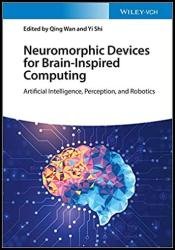 Название: Neuromorphic Devices for Brain-inspired Computing: Artificial Intelligence, Perception, and Robotics
Название: Neuromorphic Devices for Brain-inspired Computing: Artificial Intelligence, Perception, and RoboticsАвтор: Qing Wan, Yi Shi
Издательство: Wiley-VCH
Год: 2022
Страниц: 259
Язык: английский
Формат: pdf (true)
Размер: 10.1 MB
Explore the cutting-edge of neuromorphic technologies with applications in Artificial Intelligence.
In Neuromorphic Devices for Brain-Inspired Computing: Artificial Intelligence, Perception, and Robotics, a team of expert engineers delivers a comprehensive discussion of all aspects of neuromorphic electronics designed to assist researchers and professionals to understand and apply all manner of brain-inspired computing and perception technologies. The book covers both memristic and neuromorphic devices, including spintronic, multi-terminal, and neuromorphic perceptual applications.
Neuromorphic Devices for Brain-inspired Computing provides an overview of the development on neuromorphic electronics, which aimed at building a neuromorphic computing system from the bottom up. Neuromorphic computing, also called brain-like computing, is one promising computing paradigm in the post-Moore’s Law era. The models, approaches, and hardware for neuromorphic computing are designed by replicating the neural network structures and information processing principles of the human brain. Just as the metal-oxide-semiconductor field-effect transistors (MOSFETs) to the integrated circuits, the fundamental neuromorphic device is the key element for building a neuromorphic computing system. Hence, it is urgent and meaningful to provide a comprehensive view on these neuromorphic devices and to look into the possibility of this new wave. Thus, we invited some experts from each neuromorphic electronics related sub-topic to fulfill the aforementioned target together.
Summarizing recent progress made in five distinct configurations of brain-inspired computing, the authors explore this promising technology’s potential applications in two specific areas: neuromorphic computing systems and neuromorphic perceptual systems. The book also includes:
A thorough introduction to two-terminal neuromorphic memristors, including memristive devices and resistive switching mechanisms
Comprehensive explorations of spintronic neuromorphic devices and multi-terminal neuromorphic devices with cognitive behaviors
Practical discussions of neuromorphic devices based on chalcogenide and organic materials
In-depth examinations of neuromorphic computing and perceptual systems with emerging devices
Chapter 1 introduces the device structure, materials, and switching behaviors of memristive devices, as well as the state-of-the-art memristive synapses, neurons, and neural networks. Chapter 2 is focused on the spintronic device-based neuromorphic emulation and computing. Spintronic devices have unique properties such as low power, nearly infinite endurance, good scalability, and grate compatibility with the complementary metal-oxide-semiconductor (CMOS) technology and are recently recognized as promising candidates for neuromorphic devices.
Chapter 3 introduces multi-terminal devices, which are mainly transistors. Interesting dendritic integration functions and dendritic algorithms based on this type of devices are also discussed and briefly introduced.
Chapter 4 is devoted to neuromorphic devices based on chalcogenide materials that show the intriguing memory switch and threshold switch behaviors to emulate synaptic plasticity and neural firing functions.
Chapter 5 is devoted to neuromorphic devices based on organic materials. Organic neuromorphic devices are involved in both two-terminal devices and three-terminal devices, and they are notable for building bionic systems.
Chapter 6 is mainly about the neuromorphic computing implemented by emerging devices. The neuromorphic devices facilitate energy-efficient computing in deep neural networks (DNNs), spiking neural networks (SNNs), and other intelligent systems.
Chapter 7 describes another promising direction for neuromorphic electronics: the building of neuromorphic perceptual systems by emerging devices. This direction is aimed to endow intelligence to the bionic systems.
Perfect for materials scientists, biochemists, and electronics engineers, Neuromorphic Devices for Brain-Inspired Computing: Artificial Intelligence, Perception, and Robotics will also earn a place in the libraries of neurochemists, neurobiologists, and neurophysiologists.
Скачать Neuromorphic Devices for Brain-inspired Computing: Artificial Intelligence, Perception, and Robotics